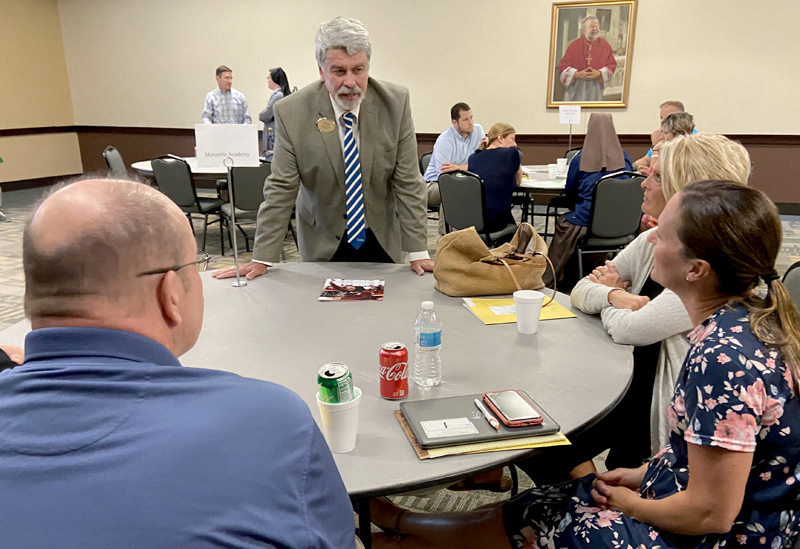Five-year strategic planning process aims to strengthen diocesan high schools

Dr. Bob Tift of Partners in Mission talks with Brooke Rick, principal of Marquette Academy in Ottawa, and her team during the "soft launch" of a new strategic planning process for Catholic high schools in the Diocese of Peoria on June 10. (The Catholic Post/Jennifer Willems)
Catholic high schools in the Diocese of Peoria have begun a strategic planning process with the goal of not only growing stronger in terms of Catholic identity and living their mission, but also supporting their mission in new and creative ways over the next five years.
A “soft launch” of the collaboration between Partners in Mission, a Boston-based consulting group, and Schlarman Academy in Danville, The High School of Saint Thomas More in Champaign, Marquette Academy in Ottawa, Notre Dame High School in Peoria, and Alleman High School in Rock Island took place on June 10 at the Spalding Pastoral Center in Peoria. Also attending was Sean Foster, principal of Central Catholic High School in Bloomington, which went through the strategic planning process with Partners in Mission two years ago and is already seeing results in its first year of implementation.
Central Catholic’s positive experience set the stage for the diocese’s Catholic high schools to participate in the process system-wide.
“We have no business running private schools. We have a commitment and a mission to run Catholic schools. . . . We have to have a strong Catholic identity in the schools. That is what makes us unique.” — Coadjutor Bishop Louis Tylka
“They all have different challenges, but they’re all challenged in some way,” he said. “And so the beauty of doing this together is it shows that we are a school system — we can learn from one another.”
Partners in Mission is the right group to lead the process since it’s solely focused on helping Catholic high schools, Bishop Tylka explained.
“We have no business running private schools. We have a commitment and a mission to run Catholic schools,” he said. “A concern as a bishop, but also a concern that is shared by the priests and pastors, is we have to have a strong Catholic identity in the schools. That is what makes us unique. That makes us different from any private school.”
BEST PRACTICES
What Partners in Mission does is lay out a nine-month timetable that provides guidance for forming a steering committee, collecting information, conducting “climate surveys” on various issues, and engaging members of the community to develop goals and objectives in eight domains: academics and technology, advancement and communication, enrollment and marketing, facilities and technology infrastructure, finance, governance and student life, with Catholic identity at the heart of it all. There will be a “hard launch” in September and a strategic planning weekend retreat next February and March.
Drafts of each school’s new strategic plan are to be sent to the Office of Catholic Schools next spring for approval.
Dr. Bob Tift of Partners in Mission was in Peoria for the meeting on June 10 and walked the school leaders through the timetable. He assured them that they were not be expected to work alone, but would have help from him along the way.

Sean Foster of Central Catholic High School in Bloomington said Partners in Mission has helped the school bridge the gap between their mission and their vision and start to take the action steps needed to grow stronger.
“We provide support and resources to Catholic school systems so they can thrive and grow,” he said, adding that one of the strengths of Partners in Mission is being able to share best practices from around the country.
The former president of Benilde-St. Margaret’s School in St. Louis Park, Minnesota, Tift was once in their shoes. He said what he learned in developing a strategic plan with Partners in Mission gave him the confidence to talk to people about his school and why their support was so important. But it goes beyond asking for money, he said.
“It’s about sharing the mission with passion and telling those stories,” Tift said. “Gone are the days when we can be the best-kept secret.”
Tift added that there are many misconceptions and myths about Catholic schools that need to be addressed.
“There are still a lot of people out there that think we have inferior academics, that we have uncertified teachers,” he told The Post. “We need to spend more time and be intentional about how we market ourselves.”
“THE PROCESS WORKS”
Sean Foster said working with Partners in Mission helped Central Catholic to bridge the gap between their current mission and the vision they have for the school.
“What they really focus on is helping Catholic schools support their mission,” he said. “As I’ve gone through this process I’ve really understood — it all goes together — there’s living the mission and supporting the mission.
“Living the mission would be our Catholic identity, our academics, our student life,” Foster explained. “Supporting the mission would be basically everything else that is necessary to make those things happen. A big part of that is advancement.”
Due to their work with Partners in Mission, Central Catholic has been able to do a much better job of engaging the community and utilizing the skills and talents that are out there, he said.
“There are a lot of good business men and women who love the Catholic church and love the Catholic schools and have a lot of gifts that we can lean on and provide insights, advice, and resources we wouldn’t otherwise have,” according to Foster.
The community is also showing support for the school’s mission financially. He said the capital campaign has grown from $120,000 when he started at Central Catholic and looks to close this year above $500,000.
“We’ve been successful, but we still have issues we’re working through,” Foster said. “We’re still at the beginning. Time will tell.”
“I’m excited. I know in my heart the process works.” — Dr. Sharon Weiss
“Everybody is doing strategic planning because people want to know where they’re at and where they going to be in five years, 10 years,” Weiss said. “I think of OSF Healthcare System right here in our diocese. They do it on a continual basis.”
Most households have a budget, which includes planning for vacations and groceries, among other things, she said, noting that without an honest examination there can be no growth or improvement.
“I’m excited. I know in my heart the process works,” Weiss said. “I know the good it will do for our schools . . . to let everyone know who we are and why we do what we do.”





